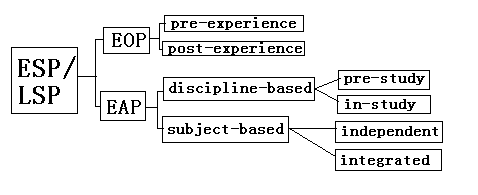Teaching Method
& LSP
Applet loading....
「Approach,Method,Procedureレベルで日本の英語教育を見直す」
~Approaches and method in language teaching~
・According to Edward Anthony in 1963, approach is the level
at which assumption and beliefs about language and language
learning are specified; method is the level at which theory is
put into practice and at which choices are made about the
particular skills to be taught , the content to be taught, and
the order in which the content will be presented; technique is
the level at which classroom procedure are described. ・Theory
of language is divided into three different theoretical views;
the structural view, the functional view, and the interacional
view. The structural view;"Audio lingual Method",
"Total hysecal Response",and "Silent Way".
Secondly the functional view; "Notional
Syllabuses(Willkins)".
Thirdly the interactional view; "Language is seen as a tool
for the creation and maintenance of social relations".
"Audio lingual Method": Also aural-oral method ,mim-mem
method . A method of foreign or second language teaching which
emphasizes the teaching of speaking and listening before reading
and writing, and it uses dialogues and drills, it discourages use
of the mother tongue in the classroom. it often makes use of
contrastive analysis. The theory behind the audiolingual method
is the aural-oral approach to language teaching, which contains
the followings; speaking and listening are the most basic
language skills, each language has its own unique structure and
rle system, a language is learned through formin habit. These
ideas were based partly on the theory of structural linguistics
and parly on behaviourism.
オーラルアプローチは現在でもフォームを中心に学習していく上で、実際に授
業に取り入れられる。特に入門期外国語教授においては大変重要な要素の1つだ
と思う。
確かに、それだけでは不十分でフォームに特有の、語彙の制限や創造性に欠ける面が多々あるので補足的教授法がとられなければならないだろう。
文法的に重視する場面などは取り入れていくのは良いが、毎回となるとやって
も短時間が良いと思う。実際のコミュニケーションにおいてはフォームよりもミ
ーニング、「意味づけ」が重要である。人と人との間のコミュニケーションによ
ってその語彙の持ちうる意味が決定されるのであって、言葉は生きているのであ
る。
その点をすべてカバーするには Palmer,Fries の理論だけでは不十分である
。
"Total physical Response"
A language teaching method developed by Asher in which items are
presented in the foreign language as orders, command, and
instructions requiring a physical response from the learner. This
is thought to lead to more meaningful and effective learning.
幼児の母語習得の課程から以下の3つを仮定した。
1)聴く作業がはなす作業より遙かに先行すること
2)聴く作業を特殊な方法、つまり、体で反応することによって学習している
こと
3)聴く作業は幼児がいずれ言葉を話し始める際の”レディネス”としての働
きをすること
「言語習得の場合、脳と神経系統は特殊な順序と様式のもとに生物学的にプロ
グラム化されており、これは母語であろうと外国語であろうとかわりはない。そ
の特殊な順序とは話す前に聴くことであり、特殊な様式とは言語と学習者の身体
の動きを一致させることである。」
これはペンフィールド、レネバーグの理論とも一致しており確信がありそうで
ある。しかし、日本の場合は中学校で初めて英語に触れる生徒も少なくないし、
第一にESPとの関係からそこまでして外国語学習に取り組む環境ではない。長期
的に確実に外国語を身につけようとするなら上記のTPRは有効であろうが、時間
的な学習量を考えても日本の環境には馴染まないであろう。よほど英語に時間を
割くような環境になった場合はAsherの理論も見直されるであろう。
"Silent Way"
A method of foreign-language taching developed by Gattegno
which makes use of gesture, mime, visual aids, wall charts, and
in particular Cuisiniere rods(wooden stick of different lengths
and colors) that the teacher uses to help the students to talk.
the method takes its name from the relative silence of the
teacher using these techniques.
教師がモデルを示したり、説明を加えたりすることがほとんどなく専ら生徒
に活動させようとするものである。原則は"Watch,Give
only what is needed,Wait" である。
しかも、"much language and little vocabulary"なのである。
当然ではあるが習熟には時間を要し生徒主体の活動は良いのだが、まったく日
本の環境には馴染まない。特別な語学研修センターで長期間学習するならまだし
も中学校教育課程の一つとしの英語科では絶対に無理である。
教材教具を工夫して用いるのは良いのだがそれに対して教師からの助言がない
となると授業の組立は難しいだろう。
"Notional Syllabuses(Willkins)"
Also notional functional syllabus: In language teaching a
syllabus in which the language content is arranged according to
the meanings a learner needs to express through language and
grammar.a notional syllabus is contrasted with a grammatical
syllabus or structural syllabus(one which consists of a sequence
of graded language items) or a situational syllabus (one which
consists of situations and the relevant language items. notional
syllabus contains: a) the meanings and concepts the learner needs
in order to communicate and the language needed to express them..
These concepts and meanings are called notions. b)the language
needed to express different functions or speech acts. These
notions and functions are then used to develop learning
「概念・機能シラバス」
①意図的な言語内容の選択配列を排除、その代わりに、目標言語によるコミニ
ュケー ション活動を通して解決すべき課題(タスク)が選択、配列されシラバ
スを構成
②ドリルや誤りの訂正といった言語形式に焦点をあてて教授する事の回避
この理論は現行の指導要領に近くもっとも日本で普及しているやり方だと思う
。
特にロング、ヌーナンの「タスクベースドゥシラバス」などは私も実際個人的
にずっと応用してきた。pedigogicalであっても目的のある活動には生徒は興味
を示すものである。 問題点は多々あるが、経験から言うと第一に「基礎学
力」である。
何が英語の基礎学力なのかということもあるが、とりあえずライティングの力
、リーディングの力が欠如してくる。話す力はつくが文法的にかなり不安定であ
る。
結論から言わせてもらえば、Fluencyな活動であるから当然とは言え毎回この
種の授業を行っているとライティングがリーディングが減る。また、友達や担当
教員の音声にはなれるが幅がそれ以上広がらない。文法指導がなされないため、
インターラクティブであっても個人の思考がほとんどない。Accuracy
的な面も 中学の段階では必要である。
特に入門期においては言語形式の認識が不十分ななかで行われると、一見イン
ターラクティブな活動も実は生徒には何の力にもなっていない場合が多い。これ
はAccuracyの不足から起こる問題で、アウトプット偏重主義がもたらす「基礎学
力の欠如」に他ならないと思う。教育活動の全体の中の英語科であるのだから時
間的な面、効率的な面、他教科との相互関連も現実では無視できない。
The English for specific purpose
movement likewise begins not from a structural thiory of
language but from a functional account of learner needs(Robinson
1980)
"Strevens attributes the recent expansion of LSP(Languae
specific purpose)courses to the "global trend towards
learner-centered education" , with its emphasis on learners
needs and interest. It may also be seen as a product of the rapid
technological and societal changes and the increased mobility of
populations which are features of our age....... EST(English
for science and technology) has come to the fore because English
is consedered the major international language in these
areas......nearly two-thirds of engineering literature appeared
in English .With the development of LOP(Language
for occupational purposes),teachers have gone beyond the
traditional reading approach of LST/EST........ EEP(English
for educational purposes),for which Robinson proposes EAP(English
for Academic purposes),prepares students to study other subjects
in English as an Auxiliary Language(EAL), or to undertake
specialized courses in English-speaking universities. EAP
goes beyond language study to training in study skills:listening
to lectures and taking notes on these and on reading in the field
;writing reports and papers; answering questions on specialized
material orally............. EOP applies less to the
requirements of highly educated professionals and more to the
everyday needs of working people. This area, as LOP, is important
for languages other than English, since our epoch is witnessing a
substantial migration of workers from less industrialized
countries to areas of high production. These workers need to
communicate in work situations with foremen and fellow
workers................the need for LSP in second language and
bilingual situations, even at the ELL stage, needs to be
stressed, Children must be prepared, not only for everyday
communication in the language, but also for integration into an
ongoing school program in that language. This means acquaintance
with the conccepts and terminology their future classmates will
have acquired in their earlier classes, as well as facility in
performing arithmetic operations in the second language, and
familiarity with mathematical fomulas, grammatical
categories,...........

Rivers,Strevensの「英語の必要性」を引用したが、日本の英語教育を考える
にはまずこの ESPを考えて教授していく必要がある。簡単に”英語は国際語だか
ら必要だ”で良いのだろうか?そのことを学習者はLOP/EOPとして認識している
のだろうか?私は日本の場合は確実にEAPであると認識している。もし、今後も
環境がEAPでありつづけるなら、はっきり言って文法指導はとても大切でその時
間をコミュニケーション以上に使う方が良いのである。イギリスの上流階級でラ
テン語を学んだように。。。。その使用目的はアカデミックなものであり、職業
像などは感じられない。そこには外国資本を介在しない日本の豊かさがある。ま
さに外国資本がなくても十分な繁栄が感じられるのである。これをファンクショ
ン中心のシラバスに変えていくにはまず環境を変えていく必要がある。例:留学
する。授業時間を増やし、英語量を増やす。常に英語で生活する。他教科も英語
で授業する(←実践校あります。)早期英語学習に取り組む。英語を使った職業
像を抱く。目的意識をはっきりともった英語学習にする。等。。。日本は英語を
せっぱ詰まった状態で将来的に確実的な必要性を持っていないことが最大の英語
教育の問題である。
私のとっているアンケートでも「英語の必要性」が載っています。12/末日で集計終了しました。
これは"Needs Analysis"の作業として行ったものであり、現在の英語教育における、過渡期では必要とされることであると思っている。特に、教育全体が問われている今日、学習指導要領も平成11年に改訂される。(過渡期においては過去、”Eclectic
Method"が叫ばれることが多くなっている、現在がそうである、指導法と生徒実態に行き詰まりと不安を感じているのである)
今後もこの種のアンケートがどんどんと出てくると思われる、それらのサンプルや意見を統計的にまとめあげ新しい方向に進むのが良いだろう。英語指導法は常に問題視され過去も現在もそして未来もその指導法は変化し続けるのである。 社会のニーズの変化に伴って。。。。。
(参考) "Needs Analysis"

英語教育でカリキュラムを開発するのに際して配慮すべきことの一つは、学習者が英語を習得したらそれを将来どういう目的で使うのかということを知り、それとの関連で英語カリキュラムの内容を設計する事である。
しかし、将来の目的がはっきりとしていない状況で、目的がいかなるものであっても、基本的に「聴く、話す、読む、書く」の4技能は基礎基本として学ばれていなければならないだろう。そこには英語科が教育活動に存在するという前提つきである。英語科そのものがいらない、となってしまえば。。。。。話はまた別であろう。
『読むための英語』というのがひとところ一躍有名であったし、現時点でも大学入試問題等から察してそうなのだろう。
読解力が生徒側にもニーズとして存在している。現場ではどうかというと、入試英語から脱却すべくコミュニケーション・発話活動が中心となりゲーム感覚の楽しい英語を目指している。
私のアンケートの収集結果においては「国際化」=「英語のニーズ」という考えが多く、具体的には「リスニング」(4技能では)が多かった。「情報化社会」にあって、いかに速く的確に情報を収集するかといえば、「読む」「聴く」の技能である。とくに現在、「臨界期」「早期英語」「小学校英語導入」等の問題から、「リスニング力」に関して注目されていると分析できる。
技能面ではないが他方で、「国際感覚」「異文化接触、外国人慣れ」「コミュニケーション力」「表現力」等、情意面レベルでのニーズが感じられている。それは、私たち日本人の文化や慣習、内面世界に基づくものであり21世紀の"Global Education"を感じさせている。
英語科は選択教科であり、諸外国を理解したりするためのツールでしかなく、その需要は英語から中国語、朝鮮語、ポルトガル語等変化していく可能性は十分ある。そして、欧米文化崇拝主義も回答頂いた方々からの御意見からだいぶ感じられなくなってきていることも重要な結果の一つである。
 back!
back!
 Next is the history of
the teaching method
Next is the history of
the teaching method


 back!
back!